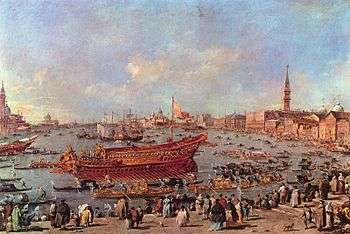The Doge on the Bucintoro near the Riva di Sant'Elena (painting)
| The Doge on the Bucintoro near the Riva di Sant'Elena | |
|---|---|
 | |
| Artist | Francesco Guardi |
| Year | 1775–1780 |
| Medium | Oil on canvas |
| Dimensions | 66 cm × 100 cm (26 in × 39 in) |
| Location | Louvre, Paris |
The Doge on the Bucintoro near the Riva di Sant'Elena (also known as The Departure of the Bucentaur for the Ascension Day Ceremony, and other similar titles) is an oil on canvas by Venetian painter Francesco Guardi, a member of the Venetian School. It was painted between 1766 and 1770, and is currently held and exhibited at the Louvre in Paris.
History
This painting entered the Louvre as a result of a confiscation in 1797 of the Count Joseph François Xavier de Pestre de Seneffe 1797's collection. It was selected by the Louvre, with eleven other paintings in the same series, at the Hôtel de Nesle; it was then sent to the Muséum de Toulouse (now a museum of natural history), which subsequently handed it back to the Louvre in exchange for a portrait by Ingres and another painting by Guardi, in 1952.[1]
This work is one of a series of twelve paintings representing the Solennità dogali (The Doge's Solemnities), in which the artist has faithfully copied the scenes drawn by Giovanni Antonio Canal and engraved by Giambattista Brustolon to commemorate the festivities at the coronation of the Doge Alvise Giovanni Mocenigo, in 1763. This has led to some confusion, and the canvases were formerly attributed to Canaletto, though their style was quite unmistakably that of Guardi.[2]
Under the First French Empire, the series was unfortunately broken up: seven remained in the Louvre, one was sent to Brussels, two to Nantes, one to Toulouse and one to Grenoble. The return in 1952 of the Toulouse painting to the Louvre, through the aforementioned exchange, has been the first step in an attempt to reassemble the set and display them in a special room.[3] Today ten paintings of the series are exhibited in the Louvre.[4][5]
This painting and another in the series represent the Festa della Sensa, the most sumptuous of all Venetian festivals. It took place each year on Ascension Day, the anniversary of the setting out of Doge Pietro II Orseolo's expedition, which achieved the conquest of Dalmatia in c. 1000. It was also a celebration of the Treaty of Venice of 1177 with the Doge Sebastiano Ziani, Pope Alexander III and the Holy Roman Emperor, Frederick Barbarossa. In a magnificent state barge, known in fact as the Bucentaur (It. Bucintoro), the Doge visited the Lido and celebrated the Marriage of the Sea ceremony of Venice with the Adriatic Sea, by casting a ring into the waters.[6]

This particular canvas shows the Bucentaur leaving Venice. Another in the series represents the Doge going to hear Mass at San Nicolò al Lido.
See also
Footnotes
- ↑ Cf. "Francesco Guardi and England", The Burlington Magazine for Connoisseurs, Vol. 82, No. 478 (Jan., 1943), pp.2-5
- ↑ C. Friedrichs, Francesco Guardi - Venezianische Feste und Zeremonien: Die Inszeinierung der Republik in Festen und Bildern, Reimer, Dietrich (2006), s.v.
- ↑ H. loyrette, The Louvre: All the Paintings, Black Dog & Leventhal (2011), s.v. "Guardi"
- ↑ Louvre:The Doge on the Bucentaur at San Niccolò del Lido
- ↑ Louvre atlas database: The Doge on the Bucintoro near the Riva di Sant'Elena
- ↑ F. Negri Arnoldi, Storia dell'Arte, Fabbri Group (1993), Vol.III, pp.376-7.
References
- Short Guardi biography in the Web Gallery of Art
- G.A. Simonson, Francesco Guardi 1712-1793, Kessinger Publishing (2010)
- Aldo Rizzi, I maestri della pittura veneta del '700, Electa - Milan 1973
External links
| Wikimedia Commons has media related to The Doge on the Bucintoro near the Riva di Sant'Elena (painting). |
- Louvre atlas database: The Doge on the Bucintoro near the Riva di Sant'Elena
- Louvre:The Doge on the Bucentaur at San Niccolò del Lido
- The Bucentaur, history (in Italian)